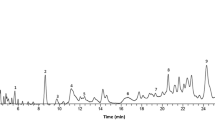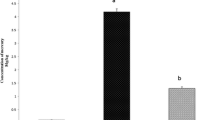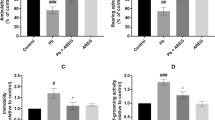Abstract
Methylmercury (MeHg) is a well-recognized environmental contaminant with established health risk to human beings by fish and marine mammal consumption. Bacopa monniera (BM) is a perennial herb and is used as a nerve tonic in Ayurveda, a traditional medicine system in India. This study was aimed to evaluate the effect of B. monniera extract (BME) on MeHg-induced toxicity in rat cerebellum. Male Wistar rats were administered with MeHg orally at a dose of 5 mg/kg b.w. for 21 days. Experimental rats were given MeHg and also administered with BME (40 mg/kg, orally) 1 h prior to the administration of MeHg for 21 days. After treatment period, MeHg exposure significantly decreases the body weight and also caused the following behavioral changes. Decrease tail flick response, longer immobility time, significant decrease in motor activity, and spatial short-term memory. BME pretreatment reverted the behavioral changes to normal. MeHg exposure decreases the DNA and RNA content in cerebellum and also caused some pathological changes in cerebellum. Pretreatment with BME restored all the changes to near normal. These findings suggest that BME has a potent efficacy to alleviate MeHg-induced toxicity in rat cerebellum.








Similar content being viewed by others
References
Clarkson TW, Magos L, Myers GJ (2003) The toxicology of mercury current exposures and clinical manifestation. Nengl J Med 349:1731–1737
Kowmulainen H, Bondy SC (1987) Increased free intrasynaptosomal Ca2+ by neurotoxic organometals: distinctive mechanism. Toxicol Appl Pharmacol 88:77–86
Marty MS, Atchison WD (1997) Pathways mediating Ca2+ entry in rat cerebellar granule cells following in vitro exposure to methylmercury. Toxicol Appl Pharmacol 147:319–330
Kunimoto M (1994) Methylmercury induced apoptosis of rat cerebellar neurons in primary culture. Biochem Biophys Res Commun 204:310–314
Nagashima K (1997) A review of experimental methylmercury toxicity in rats: neuropathology and evidence for apoptosis. Toxicol Pathol 25:624–631
Aschner M, Yao CP, Allen JW, Tan KH (2000) Methylmercury alters glutamate transport in astrocytes. Neurochem Int 37:199–206
Manfroi CB, Schwalm FD, Frizzo ME, Souza DO, Farina M (2004) Maternal milk as methylmercury source for sucking mice: neurotoxic effects involved with the cerebellar glutamatergic system. Toxicol Sci 81:172–178
Ou YC, White CC, Krejsa CM, Ponce RA, Kavanagh TJ, Faustman EM (1999) The role of intracellular glutathione in Methylmercury induced toxicity in embryonic neuronal cells. Neurotoxicology 20:793–804
Chang LW (1980) In: Spencer PS, Schaumburg HH (eds) Experimental and clinical neurotoxicity. Williams & Willkins, Baltimore, Part I. Fundamental of Experimental and clinical neurotoxicity Part II - Chemicals with neurotoxic potential, pp 508–526
Hunter D, Bomford RR, Russell DS (1940) Poisoning by methylmercury compounds. Quart J Med 9:193–213
Hunter D, Russell DS (1954) Focal cerebral and cerebellar atrophy in a human subject due to organic mercury compounds. J Neurol Neurosurg Psychiat 17:235–241
Takeuchi T (1968) Pathology of Minamata disease. In: Kutsuna M (ed) Study group of Minamata disease. Kumamoto University, Shuhan Publisher, Tokyo, pp 141–228
Takeuchi T (1982) Pathology of minamata disease. With special reference to its pathogenesis. Acta Pathol Jpn 32(1):73–99
Rosen DR (1993) Mutations in Cu/Zn superoxide dismutase gene are associated with familial amyotrophic lateral sclerosis. Nature 362:59–62
Yamashita T, Ando Y, Obayashi K, Terazaki H, Sakashita N, Uchida K, Ohama E, Ando M, Uchino M (2000) Oxidative injury is present in purkinje cells in patients with olivopontocerebellar atrophy. J Neurol Sci 175:107–110
Bckman JS, Beckman TW, Chen J, Marshall PA, Freeman BA (1990) Apparent hydroxyl radical production by peroxynitrate:implication for endothelial injury from nitric oxide and superoxide. Proc Natl Acad Sci USA 87:1620–1624
Ikeda M, Komachi H, Sato I, Himi T, Yuasa T, Murota S (1999) Induction of neuronal nitric acid oxide synthase by methylmercury in the cerebellum. J Neurosci Res 55:352–356
Shinyashiki M, Kumagai Y, Nakajima H, Homma-Takeda S, Sagai M, Shimojo N (1998) Differential changes in rat brain nitric oxide synthase in vivo and in vitro by methylmercury. Brain Res 798:147–155
Miura N, Kaneko S, Hosoya S, Furuchi T, Miura K, Kuge S, Naganuma A (1999) Overexpression of L-glutamine: D-fructose-6-phosphate amidotransferase provides resistance to methylmercury in Saccharomyces cerevisiae. FEBS Lett 458:215–218
Gupta R, Flora SJ (2006) Effect of Centella asiatica on arsenic-induced oxidative stress and metal distribution in rats. J Appl Toxicol 26:213–222
Franco JL, Braga HC, Stringari J, Missau F, Posser T, Mendes B, Leal RB, Santos ARS, Dafre AL, Pizzolatti MG, Farina M (2007) Mercurial-induced hydrogen peroxide generation in mouse brain mitochondria: protective effects of quercetin. Chem Res Toxicol 20:1919–1926
Xu Y, Li G, Han C, Sun L, Zhao R, Cui S (2005) Protective effects of Hippophae rhamnoides L. juice on lead-induced neurotoxicity in mice. Biol Pharm Bull 28:490–494
Sumathi T, Shobana C, Christinal J, Anusha C (2012) Protective effect of Bacopa monniera on methyl mercury-induced oxidative stress in cerebellum of rats. Cell Mol Neurobiol 32:979–987
Tripathi YB, Chaurasia S, Tripathi E, Upadhyay D, Dubey GP (1996) Bacopa monniera Linn. As an antioxidant: mechanism of action. Indian J Exp Biol 34:523–526
Kishora K, Singh M (2005) Effect of bacosides, alcoholic extract of Bacopa monniera Linn. (Bhrami), on experimental amnesia in mice. Indian J Exp Biol 43:640–645
Ernst E (2006) Herbal remedies for anxiety-a systematic review of controlled clinical trials. Phytomedicine 13:205–208
Shanker G, Singh HK (2000) Anxiolytic profile of standardized Brahmi extract. Indian J Pharmacol 32:152
Chowdhuri DK, Parmar D, Kakkar P, Shukla R, Seth PK, Srimal RC (2002) Antistress effects of bacosides of Bacopa monniera: modulation of Hsp7. Expression, superoxide dismutase and cytochrome P450 activity in rat brain. Phytother Res 16:639–664
Singh HK, Dhawan BN (1982) Effect of Bacopa monniera. Linn. (Bhrami) extract on avoidance responses in rat. J Ethanopharmacol 5:205–214
Saraf MK, Prabhakar S, Pandhi P, Anandh A (2008) Bacopa monniera ameliorates amnesic effects of diazepam qualifying behavioral molecular partitioning. Neuroscience 155:476–484
Russo A, Borrelli F (2005) Bacopa monniera, a reputed nootrophic plant: an overview. Phytomedicine 12:305–317
Garai S, Mahato SB, Ohtani K, Yamasaki K (1996) Dammarane type triterpenoid saponins from Bacopa monniera. Phytochemistry 42:815–820
Singh HK, Rastogi RP, Srimal RC, Dhawan BN (1988) Effects of bacosides A and B on avoidance response in rats. Phytother Res 2:70–75
Singh HK, Dhawan BN (1997) Neuropsychopharmacological effects of the ayurvedic nootropic Bacopa monniera Linn(Brahmi). Indian J Pharmacol 29:359–365
Nathan PJ, Clarke J, Lloyd J, Huchison CW, Downey L, Stough C (2001) The acute effects of an extract of Bacopa monniera on cognitive function in healthy normal subjects. Hum Psychopharmacol 16:345–351
Stough C, Lloyd J, Clarke J, Downey L, Hutchison CW, Rodgers T, Nathan PJ (2001) The chronic effects of an Bacopa monniera(Bhrami) on cognitive function in healthy human subjects. Psychopharmacology 156:481–484
Vohora D, Pal SN, Pillai KK (2000) Protection from phenytoin-induced cognitive deficit by Bacopa monniera a reputed Indian nootropic plant. J Ethanopharmacol 71(3):383–390
Anbarasi K, Vani G, Balakrishna K, CS S d (2006) Effect of bacoside A on brain antioxidant status in cigarette smoke exposed rats. Life Sci 78:1378–1384
Sumathi T, Nathiya VC, Sakthikumar M (2011) Protective effect of Bacoside-A against morphine induced oxidative stress in rats. Indian J Pharm Sci 73(4):409–415
Kim CY, Nakai K, Kameo S, Kurokawa N, Liu ZM, Satoh H (2000) Protective effect of melatonin on methyl mercury induced mortality in mice. Tohuko j Exp Med 191:241–246
Yamashita T, Ando Y, Nakamura M, Obayashi K, Terazaki H, Haraoka K, Guo SX, Ueda M, Uchino M (2004) Inhibitory effect of a-tocopherol on methylmercury-induced oxidative stress. Environ Health Prev Med 9:111–117
Parvinder K, Schulz K, Aschner M, Syversen T (2007) Role of docosahexaenoic acid in modulating methylmercury-induced neurotoxicity. Toxicol Sci 100(2):423–432
Greice MR, de Lucena S, Franco JL, Ribas CM, Azevedo MS, Meotti FC, Gadotti VM, Dafre AL, Santos AR, Farina M (2007) Cipura paludosa extract prevents methyl mercury-induced neurotoxicity in mice. Basic Clin Pharmacol Toxicol 101:127–131
Farina M, Franco JL, Ribas CM, Meotti FC, Missau FC, Pizzolatti MG, Dafre AL, Antos ARS (2005) Protective effect of Polygala paniculata extract against methylmercury induced neurotoxicity in mice. J Pharm Pharmacol 57:1503–1508
Paxinos G, Watson C (1982) The rat brain in sterotaxic coordinates. Academic, New York
Searcy DG, Macinnis AJ (1970) Hybridizatoin and renaturation of the nonrepetive DNA of higher organisms. Biochim Biophys Acta 209(2):574–577
Burton K (1956) A study of the conditions and mechanism of the diphenylamine reaction for the colorimetric estimation of deoxyribonucleic acid. Biochem J 62(2):315–332
Dische Z (1955) Colour reaction of nucleic acid components. In: Chargaff E, Davidson JN (eds) The nucleic acids, vol 1. Academic, New York, pp 285–305
Lowry OH, Rosenbrough NJ, Farr AL, Randall RJ (1951) Protein measurement with Folin phenol reagent. J Biol Chem 193:265–275
Steru I, Chermat R, Thierry B, Simon P (1985) The tail suspensions test: a new method for screening antidepressants in mice. Psychopharmacol 85:367–70
Dalvi A, Lucki I (1999) Murine models of depression. Psychopharmacol 147:14–16
Hara K, Satio Y, Kirihara Y, Yamada Y, Sakura S, Kosaka Y (1999) The interaction of antinociceptive effects of morphine and GABA receptor agonists within the rats spinal cord. Anesth Analga 89:422–427
Rosa AO, Lin J, Caliixto JB, Santos AR, Rodrigues AL (2003) Involvement of NMDA receptors and L-arginine-nitric oxide pathway in the antidepressant-like effects of zinc in mice. Behav Brian Res 61:43–50
Gralewicz S, Wiaderna D, Tomas T, Rydzynski K (1997) Behavioral changes following 4-week inhalation exposure to pseudocumene(1,2,4-trimethylbenzene) in the rat. Neurotoxicol Teratol 19:327–333
Jothi A, Sethi P, Sharma D (2007) Bacopa monniera prevents from aluminium toxicity in the cerebral cortex of rat brain. J Ethanopharmacol 111:56–62
Auger N, Kofman O, Kosatsky T, Armstrong B (2005) Low-level methylmercury exposure as a risk factor for neurologic abnormalities in adults. Neurotoxicology 26:149–157
Zahir F, Shamin J, Rizwi Haq SK, Khan RH (2005) Low dose mercury toxicity and human health. Environ Toxicol Pharmacol 20:351–360
Dietrich MO, Mantese CE, Dos Anjos G, Souza DO, Farina M (2005) Motor impairment induced by oral exposure to methylmercury in adult mice. Environ Toxicol Pharmacol 19:169–175
Fisher C, Fredrikson A, Eriksson P (2008) Coexposure of neonatal mice to a flame retardant PBDE 99(2, 2’, 4, 4’,5-pentabromodiphenyl ether) and methylmercury enhances developmental neurotoxic defects. Toxicol Sci 101(2):275–285
Gralewicz S, Wiaderna D, Lutz P, Sitarek K (2009) Neurobehavioural functions in adult progeny of rat mothers exposed to methylmercury or 2,2′,4,4′,5,5′-hexachlorobiphenyl(PCB 153) alone or their combination during gestation and lactation. Int J Occup Med Environ Health 22(3):277–291
Hodges H, Allen Y, Sinden J, Mitchell SN, Arendt T, Lantos PL, Gray JA (1991) The effects of cholinergic drugs and cholinergic-rich foetal neural transplants on alcohol-induced deficits in radial maze performance in rats. Behav Brain Res 43:7–28
Sringari J, Meotti FC, Souza DO, Santos AR, Farina M (2006) Postnatal methylmercury exposure induces hyperlocomotor activity and cerebellar oxidative stress in mice: dependence on the neurodevelopmental period. Neurochem Res 31:563–569
Roegge CS, Morris JR, Villareal S, Wang VC, Powers BE, Klintsova AY, Greenough WT, Pessah IN, Schantz SL (2006) Purkinje cell and cerebellar effects following developmental exposure to PCBs and/or MeHg. Neurotoxicol Teratol 28:74–85
Chuu JJ, Liu SH, Shiau SYL (2007) Differential neurotoxic effects of methylmercury and mercuric sulphide in rats. Toxicol Lett 169:109–120
Nabi S, Ara A, Rizvi SJ (2012) Effect of methylmercury on depression like behavior in rats: a study mitigated by exogenous vitamins. Iran J Pharmacol Ther 11(1):1–5
Cryan JF, Mombereau C, Vassout A (2005) The tail suspension test as a model for assessing antidepresent activity: review of pharmacological and genetic studies in mice. Neurosci Biobehav Rev 29:571–625
Weingartner H, Silberman E (1982) Models of cognitive impairment: cognitive changes in depression. Psychopharmacol Bull 18:27–42
Eto K, Yasutake A, Miyamoto K, Tokunaga H, Otsuka Y (1997) Chronic effects of methylmercury in rats. II. Pathological aspects. Tohoku J Exp Med 182:197–205
Nagashima K (1997) A review of experimental methylmercury toxicity in rats: neuropathology and evidence for apoptosis. Toxicol Pathol 25:624–630
Eto K, Tokunaga H, Nagashima K, Takeuchi T (2002) An autopsy case of Minamata disease (methylmercury poisoning)—pathological viewpoints of peripheral nerves. Toxicol Pathol 30:714–722
Chao ES, Gierthy JF, Frenkel GD (1984) A comparative study of the effects of mercury compounds on cell viability and nucleic acid synthesis in HeLa cells. Biochem Pharmacol 33(12):1941–1945
Slotkin TA, Pachman S, Kavlock RJ, Bartolome J (1985) Effect of neonatal methylmercury exposure on development of nucleic acids and proteins in rat brain: egional specificity. Brain Res Bull 14(5):397–400
Zahir F, Rizvi SJ, Haq SK, Khan RH (2006) Effect of methylmercury induced free radical stress on nucleic acids and protein: implications on cognitive and motor functions. Indian J Clin Biochem 21(2):149–152
Acknowledgments
The study was supported by Department of Medical Biochemistry, DR.ALMPGIBMS, University of Madras, Taramani Campus, Chennai 113, Tamil Nadu, India.
Author information
Authors and Affiliations
Corresponding author
Rights and permissions
About this article
Cite this article
Christinal, J., Sumathi, T. Effect of Bacopa monniera Extract on Methylmercury-Induced Behavioral and Histopathological Changes in Rats. Biol Trace Elem Res 155, 56–64 (2013). https://doi.org/10.1007/s12011-013-9756-y
Received:
Accepted:
Published:
Issue Date:
DOI: https://doi.org/10.1007/s12011-013-9756-y




